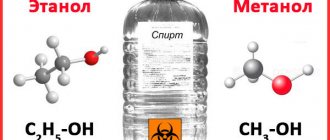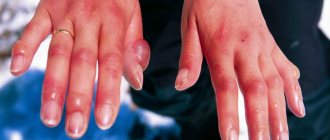Ethyl alcohol (ethanol/methylcarbinol) is one of the colorless, volatile chemical liquids that tend to ignite quickly. Ethyl alcohol is a component of alcoholic beverages and can be mixed independently with water to produce an alcohol-containing liquid (which is what alcoholics often resort to if they have access to pure ethanol). If such a liquid is consumed in large quantities, a person experiences acute ethyl alcohol poisoning. The manifestation of such pathology may have a different clinical picture depending on the dose of methylcabinol taken.
Important: ethanol poisoning can be considered those cases when the dose of alcohol entering the body is equal to and exceeds 3 g/kg of the weight of the person who drank it. It is worth knowing that an increase in the concentration of ethyl alcohol in the body can even lead to death. This result is observed when the presence of alcohol in a person’s blood is within 250-400 ml of 96% ethanol (provided that the entire volume was drunk within 30-90 minutes).
Signs of ethyl alcohol poisoning
Symptoms of ethyl alcohol poisoning: disturbances in speech, gait, consciousness, emotions, behavior, agitation followed by lethargy. Severity of poisoning:
- Mild: incoherent speech, unsteady gait, decreased criticism of one’s own actions.
- Medium: all of the above, additionally euphoria gives way to aggression.
- Severe: the person is not oriented in the area and in time.
Fatal poisoning with ethyl alcohol is accompanied by depression of consciousness and protective reflexes of a person, up to respiratory arrest, convulsions, and coma.
Signs of ethanol poisoning appear gradually in various combinations. The severity of symptoms increases as the concentration of alcohol in the blood increases.
First aid for ethyl alcohol poisoning
Acute moderate to severe ethyl alcohol poisoning requires first aid as soon as possible. First, it is necessary to carry out a differential diagnosis between poisoning with methyl alcohol or other surrogates and regular alcohol. As a rule, poisoning with alcohol surrogates is characterized by the rapid development of a coma, pronounced disorders of the central nervous system: loss of vision, lack of urine output, a relatively small dose of alcohol, etc.
In the event of the development of alcohol intoxication, the following measures must be taken:
This is where first aid for ethyl alcohol poisoning at home ends. All other activities must be carried out exclusively by medical personnel and in the conditions of a medical institution.
In the first 6 to 8 hours after stopping drinking alcohol, you should never take aspirin, analgin, or other painkillers and anti-inflammatory drugs. In combination with alcohol, they have an incredibly strong toxic effect on the gastric mucosa and liver.
The mechanism of action of ethanol on the body
When a person drinks an alcoholic drink, the substance begins to be absorbed into the blood through the walls of the digestive tract. The largest amount of alcohol penetrates the duodenum. Since ethyl alcohol is perceived by the body as a toxic substance, processes are launched aimed at neutralizing the poison.
To break down ethanol into harmless components, the liver begins to produce two enzymes:
- alcohol dehydrogenase;
- acetaldehyde dehydrogenase.
Mechanism of action of ethanol
First, the first enzyme enters the reaction, which divides the ethanol molecule into several ingredients. One of them is acetaldehyde, the toxicity of which is many times greater than the toxicity of alcohol. At this point, acetaldehyde dehydrogenase joins the process, designed to neutralize the resulting acetaldehyde. The faster the process is completed, the less harm the body will receive.
After a person has consumed an alcoholic drink, the maximum concentration of ethanol in the blood is reached after 30 minutes if the alcohol was taken on an empty stomach. This interval increases to 2 hours if there was a hearty snack before drinking alcohol.
If the amount of alcohol has been exceeded, alcohol intoxication can last for a long time, which is associated with the rate of breakdown of ethyl alcohol. This period ranges from 5 to 36 hours, and about 90% of the substance will be neutralized in the liver. About 10% of ethanol will leave the body through exhaled air, sweat or urine.
We suggest you familiarize yourself with the reasons for the absence of a hangover after drinking alcohol
Blood alcohol levels begin to decline only when the rate of alcohol consumption is below the rate of breakdown. The elimination phase (removal and destruction of ethanol) continues until all the toxic substance has left the human body.
Treatment of alcohol intoxication with ethanol
In a hospital setting, patients with alcohol poisoning receive the following treatment aimed at reducing the symptoms of ethanol poisoning:
- gastric lavage using a gastric tube,
- intravenous infusion of glucose solution with ascorbic acid,
- injections of B vitamins,
- drip injection into a vein of solutions for detoxification of the body: Reamberin, Ringer's solution, Hemodez, etc.,
- diuretics (furosemide),
- if repeated vomiting persists, antiemetic drugs (Metoclopramide) are used,
- in case of development of a coma, the vital functions of the body are maintained (the work of the heart and respiratory system).
In case of poisoning with industrial alcohol containing impurities, alcohol surrogates, the antidote ethanol is used - ordinary alcohol, which is part of all alcoholic products. It is administered intravenously at a concentration of 33%. The toxic effect of surrogates is reduced because they are displaced by ethyl alcohol from biochemical reactions.
Consequences
With a single excessive consumption of alcohol, as a rule, everything is limited to vomiting, poor health and a hangover the next morning. However, the patient may die from ethyl alcohol poisoning if:
- vomit enters the respiratory tract,
- there was a disruption in the functioning of the cardiovascular system,
- acute renal or liver failure developed.
Death from ethanol occurs especially often in the cold season. More precisely, not from ethanol itself, but from hypothermia. Alcohol increases the body's heat transfer and causes depression of consciousness. If a person in a state of intoxication stays for a long time at a low temperature or, even worse, remains sleeping on the street, hypothermia develops and can lead to death. Thus, acute ethanol poisoning sets the stage for hypothermia.
With chronic alcohol intoxication, severe disturbances in the functioning of the central nervous system, heart, liver and kidneys develop. As a rule, they lead to the death of the patient, most often due to cirrhosis of the liver.
Let's summarize
Alcohol intoxication can cause irreparable damage to the functioning of the entire body. The gastrointestinal tract, cardiovascular system, kidneys and liver become the most sensitive to alcohol. Therefore, at the first signs of poisoning, as well as in the event of the development of alcoholism, you should completely forget about alcohol and immediately begin to restore your own health . After all, there are many ways in the world to get relaxation, rest and good mood without the participation of poisonous alcoholic drinks.
Ethyl alcohol - what is it and where is it used?
Ethyl alcohol is a colorless substance with a characteristic odor. It has good volatility and easy flammability. Synonyms: methylcarbinol, ethanol or wine alcohol.
Ethanol is widely used:
- in the production of alcoholic beverages,
- disinfection measures,
- in the manufacture of medications (antidote for methyl alcohol poisoning, various solutions for transfusions and injections),
- in perfumery,
- as a fuel or solvent.
Death from this substance can occur if 250-400 ml of ethyl alcohol of 96% concentration is consumed in a short period of time (up to 1.5 hours).
Causes of intoxication
Death without treatment due to ethyl alcohol poisoning occurs due to:
- consumption of low-quality products,
- use for oral administration of substances intended for application to the skin,
- excessive use of alcohol-containing medications,
- improper use of substances containing wine alcohol,
- neglect of safety rules when working with ethanol.
The greatest danger is not so much ethanol poisoning, which in modern conditions is quite easily dealt with, but rather its surrogates.
Course of poisoning
Ethyl alcohol poisoning poses a danger to all organs and systems. There are acute and chronic poisoning, which may differ in symptoms.
Signs of acute poisoning appear if a person consumes a large dose of a toxic substance in a short period of time. Also, acute poisoning with ethyl alcohol can develop if a person has a naturally reduced tolerance to wine alcohol.
Chronic ethyl alcohol poisoning is typical for binge alcoholics who consume poison for a long time. Signs of chronic intoxication may also appear in people who work in production and do not comply with the rules for using the substance.
The effect of toxic substances on the body is as follows:
- ethanol accumulates in the central nervous system, which leads to the rapid death of nerve cells without the possibility of their recovery,
- dystrophic processes occur in the liver, first defined as hepatitis (inflammation), and over time turning into cirrhosis (death of liver cells) due to which death can occur,
- the heart and blood vessels are affected, homeostasis disorders develop, since the poison destroys red blood cells, leading to hemolytic anemia, and increases the load on the heart, which explains cardiomyopathy (at the last stage of intoxication, death can also occur from it),
- in the gastrointestinal tract, a burn of the mucous membranes occurs with the subsequent development of an inflammatory reaction, the absorption of beneficial micro- and macroelements is disrupted, which leads to weight loss, decreased immunity,
- the genitourinary system suffers (in men, the intensity of spermatogenesis decreases, problems appear in the sphere of sexual life, in women, the birth of defective children is possible due to the penetration of ethanol through the placenta).
Ethanol lethal dose calculator.
Enter the person's weight in kilograms:
Application
Today, ethanol is part of a colossal amount of substances that are regularly used in medicine, in production and even in everyday life. Therefore, the danger of such poisoning is quite high - it is difficult to predict the permissible concentration of a substance for a particular organism without knowing its characteristics.
Ethyl alcohol is used in the following areas of activity:
- The chemical industry, where ethanol simultaneously acts as an assistant for the production of various substances, as a solvent, as a component of detergents and cleaning agents and antifreeze.
- In medicine, ethanol is used as a regular component of most tinctures, and is also used to remove bacteria and neutralize poisoning.
- This substance is a key component of almost every alcoholic beverage, and is also used for preservation and formulation of food additives.
- Ethyl alcohol can also often be found in cosmetics and perfumes.
Symptoms
Various cases of intoxication show that people's susceptibility to the substance is not the same. Moreover, over time, alcoholics develop resistance to alcohol, which makes it much more difficult to become poisoned than for an ordinary person who drinks infrequently or for the first time.
Today, doctors distinguish three stages of ethyl alcohol poisoning and two types of coma - superficial and deep.
At a mild stage, the following symptoms of poisoning usually appear:
- drop in attention level
- decreased ability to remember,
- associative spectrum disorders, such as disorientation, disorders of thinking and self-control,
- reduction of criticism, excessive assessment of one’s capabilities,
- reflexes slow down and the ability to coordinate movements is impaired,
- the level of sensitivity to pain decreases.
As ethanol poisoning worsens, the mild stage changes to the moderate stage, accompanied by the appearance of symptoms of gastrointestinal damage. These include nausea, vomiting, and loss of fluid from the body.
Signs of severe poisoning will be as follows:
Without assistance, severe poisoning quickly turns first into a superficial and then into a deep coma. Superficial coma will be characterized by the preservation of primitive reactions to pain, facial grimaces, retardation of consciousness, disturbance or absence of speech. In a deep coma, a poisoned person will completely lack reflexes and reaction to the world around him.
Acute ethanol poisoning is characterized by a rapid transition from mild to severe and even comatose intoxication. At the same time, even a doctor cannot always clearly understand where one stage ends and another begins.
In case of poisoning with surrogates (for example, methyl alcohol instead of ethyl alcohol), complaints of loss of vision may appear as the first sign of intoxication.
Is it possible to die from a hangover?
Have you been struggling with ALCOHOLISM for many years without success?
Head of the Institute: “You will be amazed at how easy it is to cure alcoholism simply by taking it every day...
Read more "
A hangover is the human body’s reaction to ethyl alcohol poisoning and manifests itself differently in everyone. It happens that the symptoms of a hangover are so strong that a person thinks that he is dying. After a feast with plenty of alcohol, many people wonder: is it possible to die from a hangover? It turns out that such fears are not unfounded. In the article we will consider what consequences of drinking the night before can be fatal.
Causes of death from hangover
A person can die both after a long binge and after a single intake of alcoholic beverages for the following reasons:
- overdose of ethyl alcohol or intoxication with its decomposition products;
- exacerbation of diseases provoked by alcohol;
- the appearance of conditions resulting from drinking alcohol.
Even if a man/woman has no health problems, an alcoholic drink still affects all organs, since ethanol is a toxic substance. Death after drinking can occur from an overdose due to cardiac and respiratory arrest. Contrary to popular belief, an abundance of high-calorie snacks increases the risk of overdoing it with alcohol. Food inhibits the onset of the feeling of intoxication, and the drinker may not notice how he consumes a lethal dose of ethanol. When the remains of a large amount of alcohol enter the bloodstream, the body will not be able to process it during a hangover, and loss of consciousness and cardiac arrest will occur. Emergency doctors often only have to record the death of the patient.
The critical dose of alcohol for each person is individual and depends on his weight, age, race, and body characteristics.
Fatal diseases
Is it possible to die from a hangover, accompanied by a headache and dryness? Hardly. But profuse vomiting, severe chest pain, and high fever are symptoms of the progression of serious diseases that can be fatal.
Symptoms of a stroke
Stroke with cerebral hemorrhage occupies a leading position in the mortality statistics from ethyl alcohol poisoning. Often, the disease does not develop sharply with an immediate loss of consciousness, but in an erased form, therefore its symptoms must be distinguished from the symptoms of a regular hangover. The morning after an alcoholic binge, the patient may experience a rapidly growing headache, nausea, severe pain in the eyes, and weakness in the body when trying to get out of bed.
The tongue becomes disobedient (it is difficult to pronounce words), the face may become distorted, the leg or arm stops obeying. If you take these symptoms as typical consequences of over-drinking and get drunk, the situation can end in coma and death. A stroke can be stopped within six hours, otherwise the person will remain disabled or even die.
Alcohol-induced stroke cannot be cured at home; calling a medical team is a prerequisite for saving a life.
Pneumonia
Pneumonia is often the cause of death in people who drink alcohol in large quantities. In people suffering from alcoholism, pneumonia has an atypical onset, more rapid progression and is often disguised as other diseases. Fever and shortness of breath can easily be considered signs of overdrinking, but severe coughing and wheezing in the lungs may not be present. But the patient may complain of abdominal pain, which makes it difficult even for doctors to make a correct diagnosis. What can we say about the relatives of an experienced alcoholic who leave him to “die”, complaining that he got drunk again. Inflammation of the lungs also causes complications in other organs, so patients without proper treatment die within a few days from cardiopulmonary failure.
Heart failure
This is another common pathology that can take your life with a hangover. Damage to the “motor” of our body is accompanied by the following symptoms:
- pain in the heart;
- cold sweat;
- trembling of hands;
- shortness of breath during exercise and at rest;
- sleep disturbance;
- increase in pressure.
Quite a typical picture for a person who got drunk the day before. Therefore, the patient himself and his relatives may not attach importance to the manifestation of an emergency condition. During the period of inactivity, gas exchange between the heart and lungs is disrupted, so the patient dies from oxygen starvation.
Liver failure
The danger of this disease is that it can occur during a hangover not only in chronic alcoholics, but also in people who drink alcohol only on holidays. Depending on the dose taken, the characteristics of the body and the length of close friendship with alcohol, the rate of death of liver cells varies. Necrosis of the liver tissue can occur within a few hours, which means that the liver will not be able to function as usual. The following signs indicate severe organ damage:
- yellowing of the skin and whites of the eyes;
- pain under the ribs on the right side;
- darkening of urine;
- discoloration of stool.
The smell of liver from the mouth, confusion, and impaired motor function indicate the approach of a hepatic coma, from which the patient may not emerge.
Renal colic
Alcohol consumption by persons suffering from urolithiasis can provoke the movement of stones in the renal pelvis and ureter, which is why renal colic occurs. Severe lower back pain may radiate to the groin, abdomen or thigh. You may also experience vomiting, diarrhea, bloody urine, or even an inability to urinate. Pain from renal colic should never be tolerated. Failure to provide medical care in a timely manner can lead to acute pyelonephritis, that is, inflammation of the kidney, and this is a real threat to life.
Gastrointestinal bleeding
Before reaching the kidneys, liver, and brain, alcohol enters the gastrointestinal tract, causing desquamation of epithelial cells, swelling and erosion of the inner surface of the stomach. If a person already has chronic diseases of the stomach and intestines, for example, gastritis, drinking alcohol contributes to the appearance of ulcers. In this case, a hangover may be marked by heartburn, stomach pain, and vomiting blood. The following set of symptoms also signals gastric bleeding: fainting, headache, weakness, tarry stool. Perforation of an ulcer, that is, a breakthrough of the stomach wall, leads to acute inflammation of the peritoneum or neighboring organs. Therefore, when the above symptoms appear, the patient’s dying appearance after drinking is an indication to urgently call doctors.
Quincke's edema
Can you die from alcohol if you drink just a glass? It turns out that it is possible, but the culprit is an allergic reaction. An allergy can be either to a component of an alcoholic drink (grapes, cereals), or to dyes, flavors and other additives. If a slow-type allergic reaction leads to skin itching and hives, then a fast-type immune reaction is a direct threat to life. “Will I die from a glass of beer or wine? Is that possible?" - many will ask. Doctors will answer that Quincke's edema has caused the death of more than one person with a hangover. The first sign of such an allergy is redness and swelling of the face, up to complete swelling of the eyes. This is followed by itchy skin and swelling of the larynx. The latter does not allow a person to breathe freely and causes death within an hour, or even faster.
Recommendations for a severe hangover
A hangover, accompanied by a serious condition of the whole body, indicates alcohol poisoning and, if alcohol consumption is systematic, the development of dependence on ethyl alcohol. If every time a person thinks about how not to die from a hangover, it means that his body simply cannot cope with constant drinking.
Cravings for drinking can be eliminated with the help of natural remedies sold online.
Basic recommendations for those interested in how not to die from a hangover are as follows:
- For the usual symptoms of yesterday's binge, you need to take a lot of fluid, drink activated charcoal, and a headache remedy.
- Symptoms of an acute condition, such as repeated vomiting, heart pain, high fever, and developing swelling of the face, require calling an emergency room.
- Don't get hungover and drink coffee and tea.
- It is prohibited to take hot baths, visit the bathhouse and sauna.
Be attentive to yourself and your loved ones to prevent tragedy.
Methyl alcohol is a strong poison that affects the blood vessels of the brain. Acute poisoning with such alcohol can be classified as a common and fatal disease. When compared with ethyl alcohol, the presence of methyl alcohol in the blood reaches 100 ml. If too much alcohol enters the body, the body is negatively affected: the brain, heart and blood vessels suffer.
Poisoning
In this case, you must immediately consult a doctor for immediate assistance. Methanol belongs to the category of ethanol surrogates, which are considered counterfeits of alcohol used in alcohol. This is a false substance that does not have ethanol in stock, but also has a narcotic effect on the human body. Methyl alcohol poisoning has an extremely dangerous effect on the body.
What is the difference between ethanol and methanol? Ethanol alcohol is classified as food and medicinal and is used for cuts, burns, or for ingestion. Methanol belongs to the category of industrial alcohol, which is part of chemicals that are not suitable for oral administration. Methyl and ethyl alcohols do not differ in appearance, as well as in taste and smell. Methanol has a barely noticeable odor, but this can only be recognized by a professional.
What is the first reaction of methanol?
Symptoms of methanol intoxication include not only the use of a prohibited component, but also further negative effects on the body. Methanol is absorbed quickly into the stomach and becomes toxic acid and formaldehyde, which in small doses have an extremely adverse effect on the body, destroying cells. Since the components are excreted through the kidneys, the urinary system suffers the most. It is forbidden to take methanol even in small doses. The nervous system is affected, problems arise with the gastrointestinal system, and with large doses of the component used, a person can die. Methyl alcohol poisoning is the most common occurrence among alcoholics.
What are the signs of poisoning?
The very first symptoms of methanol intoxication include:
- Strong headache.
- Nausea.
- Abdominal pain.
- Darkening in the eyes.
- Loss of consciousness.
- Shortness of breath.
- Low pressure.
If a person drinks methanol in small doses, on the third day vision loss occurs, blindness may occur, legs and head hurt. Alcoholic coma occurs with loss of speech contact and vomiting. As soon as a deep coma occurs, sweat appears on the skin, swelling appears, the pupils dilate, and breathing becomes rapid. A person suffers from convulsive phenomena. In severe cases, the person faces more severe symptoms and death.
How to provide assistance in case of methyl alcohol poisoning?
First aid for methanol intoxication is to restore the functioning of the heart, kidneys and breathing. It is unlikely that it will be possible to provide professional assistance to a patient at home, therefore, as soon as symptoms of methanol poisoning appear, the alcoholic must be urgently taken to the emergency department. In the hospital, the patient is prohibited from giving charcoal, as it will not have the desired effect, because methanol is absorbed in a matter of seconds. If the patient ate fatty foods along with a toxic component, then absorption is much slower.
How to rinse the stomach during methyl intoxication?
Until the ambulance arrives, the patient’s stomach urgently needs to be rinsed. To do this, he needs to drink about a liter of water and hold the end of his tongue with any object to induce vomiting. At home, this method is effective. After the ambulance arrives, a special substance must be administered. What are antidotes for methyl intoxication?
- Ethanol, which can be taken orally or by drip.
- Folic acid.
How is the treatment carried out?
- Treatment must be carried out in a clinic: in the intensive care unit or toxicology department.
- A laxative using salt to warm a poisoned body.
- Vitamin complex.
- A nicotinic acid.
- Medicines are used to relieve symptoms: Reopoliglucin, glucose, sodium bicarbonate.
- If convulsions occur, Piracetam and Unithiol are prescribed.
What side effects can occur during intoxication?
The use of methanol has its side effects. The following is generally accepted:
- Heart disease. Effect of prolonged compression. To do this, you need to lie unconscious for 5 hours. The muscles become deformed, blocking the vessels of the kidneys, contributing to disastrous destruction.
- In case of poisoning with methyl alcohol, the functioning of the heart, blood vessels, and brain is disrupted due to coma.
- Vision deteriorates.
- In minimal doses of methanol, the functioning of all organs declines. The lethal dose is 100 ml. You should not experiment on the body, because anyone can become disabled.
To prevent your loved one from dying or falling into a coma due to severe methyl alcohol poisoning without waiting for an ambulance to arrive, it is necessary to provide first aid at home.
First Aid Basics
First aid for ethyl alcohol poisoning is:
- gastric lavage with a weak solution of salt or manganese (the poisoned person is asked to drink at least 1 liter of solution and then artificially induce vomiting),
- providing the body with sorbents (activated carbon is most often used, giving one tablet for every 10 kg of body weight),
- providing the patient with warmth, since intoxication can provoke chills and a decrease in body temperature,
- carrying out basic resuscitation measures in case of respiratory arrest.
If acute intoxication occurs, and the person’s condition quickly reaches a coma, then first aid is to lay the victim on his stomach so that he does not choke on vomit. Then they call an ambulance.
Features of treatment
Treatment of chronic alcohol poisoning with ethyl alcohol requires a fairly serious, comprehensive approach. The fact is that a person is already completely dependent, both physically and psychologically, on the toxic substance entering the body. It is necessary to carry out a delicate cleansing of the body, guarantee complete detoxification, and prepare the person mentally for a new style and rhythm of life. It is necessary to push at a logical level to the need to give up alcohol. Detoxification is carried out by specialists who have been working in this direction for many years.
The work must be carried out only in a specialized clinic under the supervision of highly qualified doctors; during its execution there are complications and risk to the patient’s life, therefore the presence of doctors on duty near the patient is mandatory.
At the same time, deep psychological and social work is carried out, introducing prerequisites and desires for a person to return to normal life. Treatment is complicated by the duration of alcohol consumption and the habitual lifestyle that a person adheres to. The search for motivation must be thoughtful, balanced, guaranteed ways of influence are chosen that will help the addict make the right decision.
Treatment depends on the degree of addiction to alcohol and the stage at which the person is. Using coding and forcing a person to undergo treatment does not produce results. It is important to introduce into the brain a dependent understanding that if he does not turn off the curved path, death awaits him.
Individual and group psychological sessions are conducted, problems that encourage repeated drinking are discussed. The addict completely refuses to use alcoholic beverages. If treatment is refused, our doctors will be able to have a conversation with the addict and push him to understand the need to do hard but important work on himself. We guarantee that a person close to you will be able to completely escape addiction.
Rehabilitation will take more than a month or two. As a result, the person will get used to the new way of life, will be able to fully return to society, work, study, be with friends and family without the possibility of a breakdown.
Therapy at home and in hospital
Treatment at home is permitted only for mild intoxication. Severe ethanol poisoning requires immediate professional help. It will consist of:
- repeated gastric lavages,
- rehydration therapy (restoring the volume of fluid lost by the body),
- formed diuresis (toxins are eliminated from the body faster due to an artificial increase in the amount of urine),
- connection to a ventilator when breathing stops,
- hemodialysis if kidney failure occurs,
- emergency resuscitation measures in case of cardiac arrest.
If the use of surrogate alcohol has been diagnosed, then ethanol can act as an antidote. It is administered to stop the processes of methanol binding to red blood cells, since it is able to bind to them faster, reducing the toxicity of methyl alcohol.
A specific antidote is not administered in case of ethanol poisoning. Accelerated elimination of toxins and rehydration therapy can serve as a conditional antidote.
Preventive measures
You can avoid intoxication with wine alcohol if you adhere to the following rules:
- drink in moderation
- buy alcohol in good stores, avoiding purchasing counterfeits and surrogates,
- do not drink on an empty stomach,
- give up alcohol completely if you have chronic diseases of the gastrointestinal tract, heart and blood vessels, liver or kidneys.
Ethanol consumption is not only a medical problem, but also a social one. Optimal and equally effective methods of combating it have not been invented. Until methods appear to help overcome addiction, it is necessary to know how to diagnose intoxication and provide assistance to the affected person.
Prevention measures
In order to prevent the development of dangerous situations such as alcohol poisoning, you should follow a number of useful recommendations. They are as follows:
- Avoid constant consumption of alcohol. It is worth remembering that intoxicating drinks, even in small doses, negatively affect the functioning of internal systems. You should not trust people who claim that a small dose of alcohol benefits the body.
- Know your own alcohol limit and strictly adhere to it. On average, it is believed that the maximum permissible dose of ethanol is 12 g of pure alcohol for women and 24 g for men.
- In case of pregnancy or breastfeeding, drinking any type of alcoholic beverages before driving a vehicle is strictly prohibited. Increased caution should also be exercised if there is a predisposition to alcoholism.









